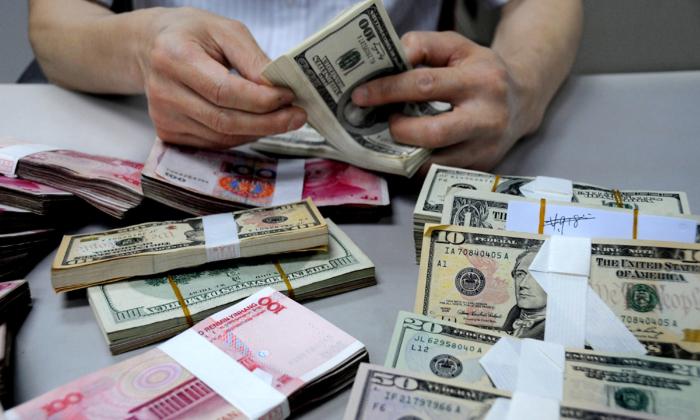The Chinese Communist Party (CCP) has recently implemented two reductions in interest rates for U.S. dollar deposits in order to stabilize the exchange rate of the Chinese yuan. Analysts have raised concerns about the rapid depreciation of the yuan, which could lead to an increased outflow of funds from China and potentially heighten the risk of local government debt.
According to a report published in China’s Securities Times on July 5, several Chinese banks have recently decreased the interest rates on U.S. dollar time deposits.
Starting from July 1, the Industrial and Commercial Bank of China and China Construction Bank eliminated the 4.3 percent annual interest rate for one-year time deposits exceeding $50,000. The new annual interest rate for time deposits exceeding $5,000 is now set at 2.8 percent.
The Bank of Communications and some commercial banks have made similar adjustments.
It marks the second time within a month that the CCP has reduced interest rates on U.S. dollar deposits. In June, large state-owned banks in China had already lowered the interest rate on U.S. dollar deposits by 100 basis points from the previous 5.3 percent.
On July 13, UK-based financial professional Fang Qi told The Epoch Times that the CCP’s intervention in the yuan’s exchange rate reflects concerns over the potential economic impact of the rapid depreciation of the currency.

Capital Outflow
Fang Qi explained that the rapid depreciation of the yuan can be attributed to two factors: the increasing interest rates in the United States and the decreasing interest rates in China, resulting in a widened interest rate differential. Consequently, international capital is expected to flow out of China.In the short term, if the yuan continues to depreciate rapidly, funds may expedite their departure from the Chinese stock market and real estate, leading to the liquidation of various yuan-denominated assets.
Data from Refinitiv reveals that in May foreign investors sold Chinese stocks worth $1.71 billion through the Shanghai-Hong Kong Stock Connect, a significant cross-border channel between mainland China and Hong Kong. This amount is substantially higher than the $659 million sold in April.
According to Morningstar, a reputable investment research firm in the United States, U.S. funds specializing in investments in China, Taiwan, and Hong Kong experienced an inflow of $2.5 billion in January but faced an outflow of $1.15 billion from February to April.
In China’s securities market, there has been a substantial outflow of funds for three consecutive months from February to April, with foreign investors reducing their holdings of assets by over $45 billion.

Continued Slump in Manufacturing and Exports
Additionally, Fang Qi explained that the rapid depreciation of the yuan implies increased import costs, particularly in manufacturing production. The rising prices of resources, food, and raw materials will contribute to import inflation, leading to stagflation and further economic decline.China’s economy is currently deteriorating, especially in the manufacturing sector, and export orders continue to be weak.
Data from China’s National Bureau of Statistics show that in June, the Purchasing Managers’ Index (PMI) for the manufacturing sector, which reflects the level of manufacturing activity, increased by 0.2 percentage points from the previous month to reach 49 percent. However, it remains below the threshold of 50 percent, indicating a contraction in production. This marks the third consecutive month that China’s manufacturing PMI has been below the threshold.
Intensifying Debt Risks
Fang Qi expressed concern that to stabilize the yuan’s exchange rate, the People’s Bank of China, the country’s central bank, may need to slow down its loose monetary policy, which could increase the risk of default for various debts.Fang Qi explained that prior to 2015, the CCP controlled the exchange rate to attract foreign capital, enhance export advantages, and promote economic development. However, since 2015, the CCP has relied on a model of printing money and promoting debt to stimulate economic growth.
According to public data, at the end of May, the debt balance of Chinese local governments reached a staggering 37.5579 trillion yuan (approximately $5.2163 trillion). Additionally, according to data from the China Iceberg think tank, the scale of local government urban investment bonds in China exceeded 65 trillion yuan (approximately $9 trillion) as of 2022. The combined debt from these two types of bonds surpasses 100 trillion yuan.
Recently, Chinese commercial banks, such as the Industrial and Commercial Bank of China and China Construction Bank, have started extending new loans with terms of up to 25 years to eligible local government financing platforms, with interest payment exemptions. However, if these debts cannot be repaid, they may turn into non-performing or bad debts.
Regarding the burden of China’s massive local government debt, the financial news website Caijing Lengyan suggests that in the event of defaults, many shareholders or creditors of U.S. banks could bear the responsibility. However, if government-owned banks in China collapse, depositors would bear the burden, which may explain the significant amount of money that has disappeared from many Chinese banks.
The equity interests and debt claims, on the other hand, remain intact, implying that the CCP is essentially taking from the people.





